Effects of Local Weather Variation on Water-Column Stratification and Hypoxia in the Western, Sandusky, and Central Basins of Lake Erie
Abstract
:1. Introduction
2. Materials and Methods
2.1. Field Study
2.2. Data Analysis
3. Results
3.1. Variation in Weather
3.2. Variation within Sites and between Years
4. Discussion
5. Conclusions
Acknowledgments
Author Contributions
Conflicts of Interest
References
- Hawley, N.; Johengen, T.H.; Rao, Y.R.; Ruberg, S.A.; Beletsky, D.; Ludsin, S.A.; Eadie, B.J.; Schwab, D.J.; Croley, T.E.; Brandt, S.B. Lake Erie hypoxia prompts Canada-U.S. study. Eos 2006, 87, 313–324. [Google Scholar] [CrossRef]
- Vanderploeg, H.A.; Ludsin, S.A.; Ruberg, S.A.; Höök, T.O.; Pothoven, S.A.; Brandt, S.B.; Lang, G.A.; Lieberg, J.R.; Cavaletto, J.F. Hypoxia affects spatial distributions and overlap of pelagic fish, zooplankton, and phytoplankton in Lake Erie. J. Exp. Mar. Biol. Ecol. 2009, 381, S92–S107. [Google Scholar] [CrossRef]
- Charlton, M.N. Oxygen depletion in Lake Erie: Has there been any change? Can. J. Fish. Aquat. Sci. 1980, 37, 72–81. [Google Scholar] [CrossRef]
- Zhou, Y.T.; Obenour, D.R.; Scavia, D.; Johengen, R.H.; Michalak, A.M. Spatial and temporal trends in Lake Erie hypoxia, 1987–2007. Environ. Sci. Technol. 2013, 47, 899–905. [Google Scholar] [CrossRef] [PubMed]
- Scavia, D.; Allan, J.D.; Arend, K.K.; Bartell, S.; Beletsky, D.; Bosch, N.S.; Brandt, S.B.; Briland, R.D.; Daloğlu, I.; DePinto, J.V.; et al. Assessing and addressing the re-eutrophication of Lake Erie: Central basin hypoxia. J. Great Lakes Res. 2014, 40, 226–246. [Google Scholar] [CrossRef]
- Bolsenga, S.J.; Herdendorf, C.E. Lake Erie and Lake Saint Clair Handbook; Wayne State University: Detroit, MI, USA, 1993. [Google Scholar]
- Rucinski, D.K.; Beletsky, D.; DePinto, J.V.; Schwab, D.J.; Scavia, D. A simple 1-dimensional, climate based dissolved oxygen model for the central basin of Lake Erie. J. Great Lakes Res. 2010, 36, 465–476. [Google Scholar] [CrossRef]
- NOAA Coastal Services Center. Sustainable Tourism: Increasing the Economic Impact While Preserving the Environment in Ohio. Available online: http://www.lakecountydevelopmentcouncil.org/april-2010/ (accessed on 12 April 2017).
- Edwards, W.J.; Conroy, J.D.; Culver, D.A. Hypolimnetic oxygen depletion dynamics in the central basin of Lake Erie. J. Great Lakes Res. 2005, 31, 262–271. [Google Scholar] [CrossRef]
- Wetzel, R.G. Limnology Lake and River Ecosystems; Elsevier Academic Press: San Diego, CA, USA, 2001. [Google Scholar]
- Rosa, F.; Burns, N.M. Lake Erie central basin oxygen depletion changes from 1929–1980. J. Great Lakes Res. 1987, 13, 684–696. [Google Scholar] [CrossRef]
- Gilbertson, M. Are causes knowable? Some consequences of successional versus toxicological interpretations of the Great Lakes Water Quality Agreement. Can. J. Fish. Aquat. Sci. 2011, 54, 483–495. [Google Scholar] [CrossRef]
- Schertzer, W.M.; Saylor, J.H.; Boyce, F.M.; Robertson, D.G.; Rosa, F. Seasonal thermal cycle of Lake Erie. J. Great Lakes Res. 1987, 13, 468–486. [Google Scholar] [CrossRef]
- Conroy, J.D.; Boegman, L.; Zhang, H.; Edwards, J.D.; Culver, D.A. “Dead zone” dynamics in Lake Erie: The importance of weather and sampling intensity for calculated hypolimnetic oxygen depletion rates. Aquat. Sci. 2011, 73, 289–304. [Google Scholar] [CrossRef]
- Michalak, A.M.; Anderson, E.J.; Beletsky, D.; Boland, S.; Bosch, N.S.; Bridgeman, T.B.; Chaffin, J.D.; Cho, K.; Confesor, R.; Daloğlu, I.; et al. Record-setting algal bloom in Lake Erie caused by agricultural and meteorological trends consistent with expected future conditions. PNAS 2014, 110, 6448–6452. [Google Scholar] [CrossRef] [PubMed]
- Burns, N.M.; Rockwell, C.D.; Bertram, P.E.; Dolan, D.M.; Ciborowski, J.J.H. Trends in temperature, Secchi depth, and dissolved oxygen depletion rates in the central basin of Lake Erie, 1983–2002. J. Great Lakes Res. 2005, 31, 35–49. [Google Scholar] [CrossRef]
- Conroy, J.D. Testing the Algal Loading Hypothesis: The Importance of Sandusky River Phytoplankton Inputs to Offshore Lake Erie processes. Ph.D. Thesis, The Ohio State University, Columbus, OH, USA, 2007. [Google Scholar]
- Daloğlu, I.; Cho, K.H.; Scavia, D. Evaluating causes of trends in long-term dissolved reactive phosphorus loads to Lake Erie. Env. Sci. Technol. 2012, 46, 10660–10666. [Google Scholar] [CrossRef] [PubMed]
- Beletsky, D.; Hawley, N.; Rao, Y.R.; Vanderploeg, H.A.; Beletsky, R.; Schwab, D.J.; Ruberg, S.A. Summer thermal structure and anticyclonic circulation of Lake Erie. Geophsys. Res. Lett. 2012, 39, L06605. [Google Scholar] [CrossRef]
- NOAA Great Lakes Environmental Research Laboratory. Real-Time Meterological Network. Toledo Light #2. Available online: https://www.glerl.noaa.gov/metdata/tol2/ (accessed on 9 July 2012).
- NOAA Data Buoy Center. Station 45005-W Lake Erie 16 NM Northwest of Cleveland, OH. Available online: www.ndbc.noaa.gov/station_page.php?station=45005 (accessed on 10 April 2017).
- Environment Canada. Lake Erie Ice Data. Available online: www.ec.gc.ca/glaces-ice/?lang=En/ (accessed on 12 April 2017).
- National Weather Service. Cleveland Office. Available online: www.weather.gov/cle/ (accessed on 12 April 2017).
- Steinhart, G.B.; Leonard, N.J.; Stein, R.A.; Marschall, E.A. Effects of storms, anglers, and predators on smallmouth bass (Micropterus dolomieu) nest success. Can. J. Fish. Aquat. Sci. 2005, 62, 2649–2660. [Google Scholar] [CrossRef]
- Foley, B.; Jones, I.D.; Maberly, S.C.; Rippey, B. Long-term changes in oxygen depletion in a small temperate lake: Effects of climate change and eutrophication. Freshw. Biol. 2011, 57, 278–289. [Google Scholar] [CrossRef]
- Zhou, Y.; Michalak, A.M.; Beletsky, D.; Rao, Y.R.; Richards, R.P. Record-breaking Lake Erie hypoxia during 2012 drought. Environ. Sci. Technol. 2015, 49, 800–807. [Google Scholar] [CrossRef] [PubMed]
- Blumberg, A.F.; Di Toro, D.M. Effects of climate warming on dissolved oxygen concentrations in Lake Erie. Trans. Am. Fish. Soc. 1990, 119, 210–223. [Google Scholar] [CrossRef]
- Bosch, N.S.; Evans, M.A.; Scavia, D.; Allan, J.D. Interacting effects of climate change and agricultural BMPs on nutrient runoff entering Lake Erie. J. Great Lakes Res. 2014, 40, 581–589. [Google Scholar] [CrossRef]
- Dai, A. Increasing drought under global warming in observation and models. Nat. Clim. Chang. 2012, 3, 52–58. [Google Scholar] [CrossRef]
- Shimoda, Y.; Azim, M.E.; Perhar, G.; Ramin, M.; Kenney, M.A.; Sadraddini, S.; Gudimov, A.; Arhonditsis, G.B. Our current understanding of lake ecosystem response to climate change: What have we really learned from north temperate deep lakes? J. Great Lakes Res. 2011, 37, 173–193. [Google Scholar] [CrossRef]
- Magnuson, J.J.; Webster, K.E.; Assel, R.A.; Bowser, C.J.; Dillon, P.J.; Eaton, J.G.; Evans, H.E.; Fee, E.J.; Hall, R.I.; Mortsch, L.R.; et al. Potential effects of climate changes on aquatic systems: Laurentian Great Lakes and Precambrian Shield Region. Hydrol. Process. 1997, 11, 825–871. [Google Scholar] [CrossRef]
- Lofgren, B.M.; Quinn, F.H.; Clites, A.H.; Assel, R.A.; Eberhardt, A.J.; Luukkonen, C.L. Evaluation of potential impacts on Great Lakes water resources based on climate scenarios of two GCMs. J. Great Lakes Res. 2002, 28, 537–554. [Google Scholar] [CrossRef]
- Wang, J.; Bai, H.; Hu, H.; Clites, A.; Colton, M.; Lofgren, B. Temporal and spatial variability of Great Lakes ice cover, 1973–2012. J. Clim. 2012, 25, 1318–1329. [Google Scholar] [CrossRef]
- Agbeti, M.D.; Smol, J.P. Winter limnology: A comparison of physical, chemical and biological characteristics in two temperate lakes during ice cover. Hydrobiologia 1994, 304, 221–234. [Google Scholar] [CrossRef]
- Fang, X.; Stefan, H.G. Simulations of climate effects on water temperature, dissolved oxygen, and ice and snow covers in lakes of the contiguous United States under past and future climate scenarios. Limnol. Oceanogr. 2009, 54, 2359–2370. [Google Scholar] [CrossRef]
- Winder, M.; Schindler, D.E. Climate change uncouples trophic interactions in an aquatic ecosystem. Ecology 2004, 85, 2100–2106. [Google Scholar] [CrossRef]
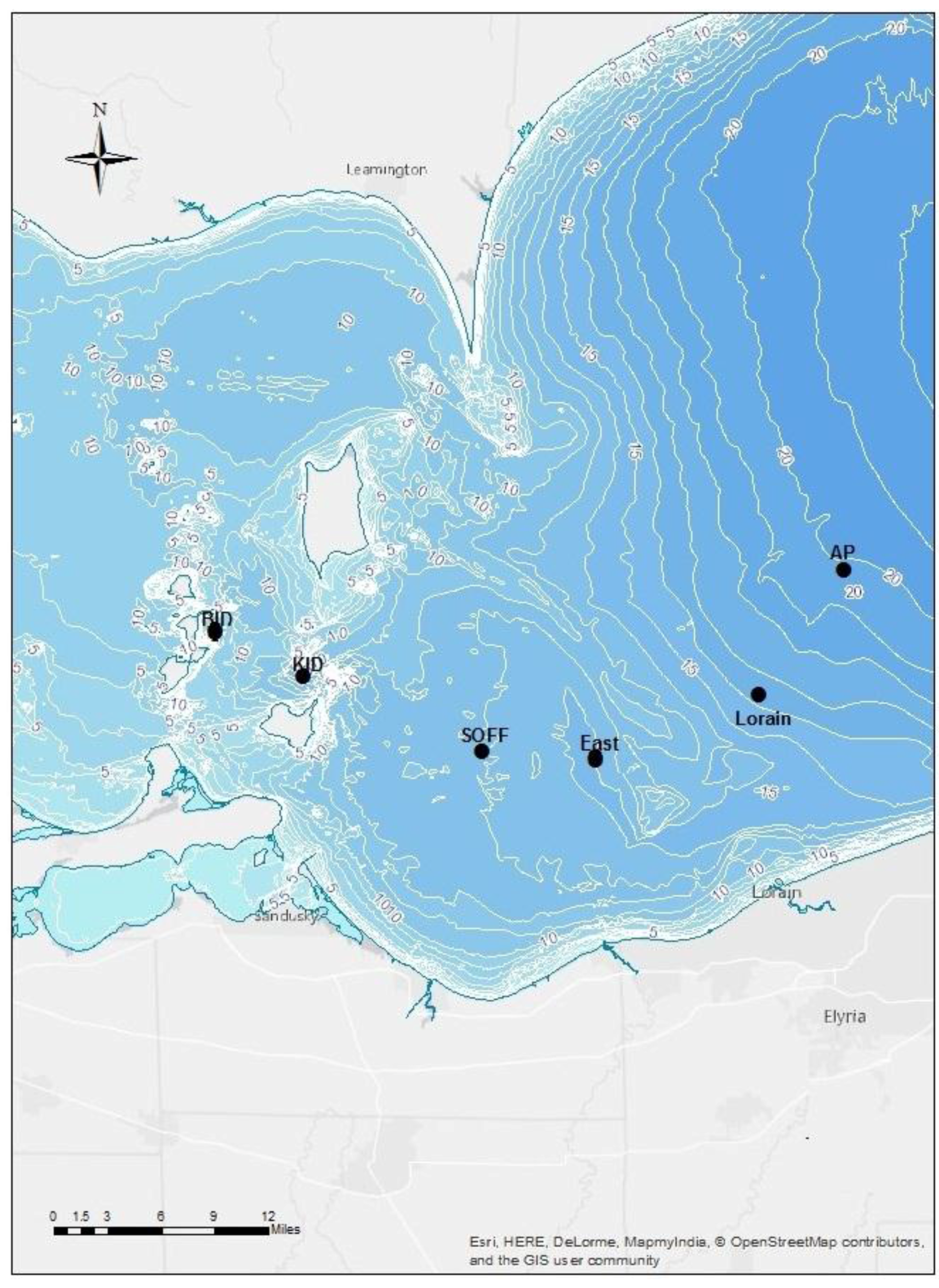

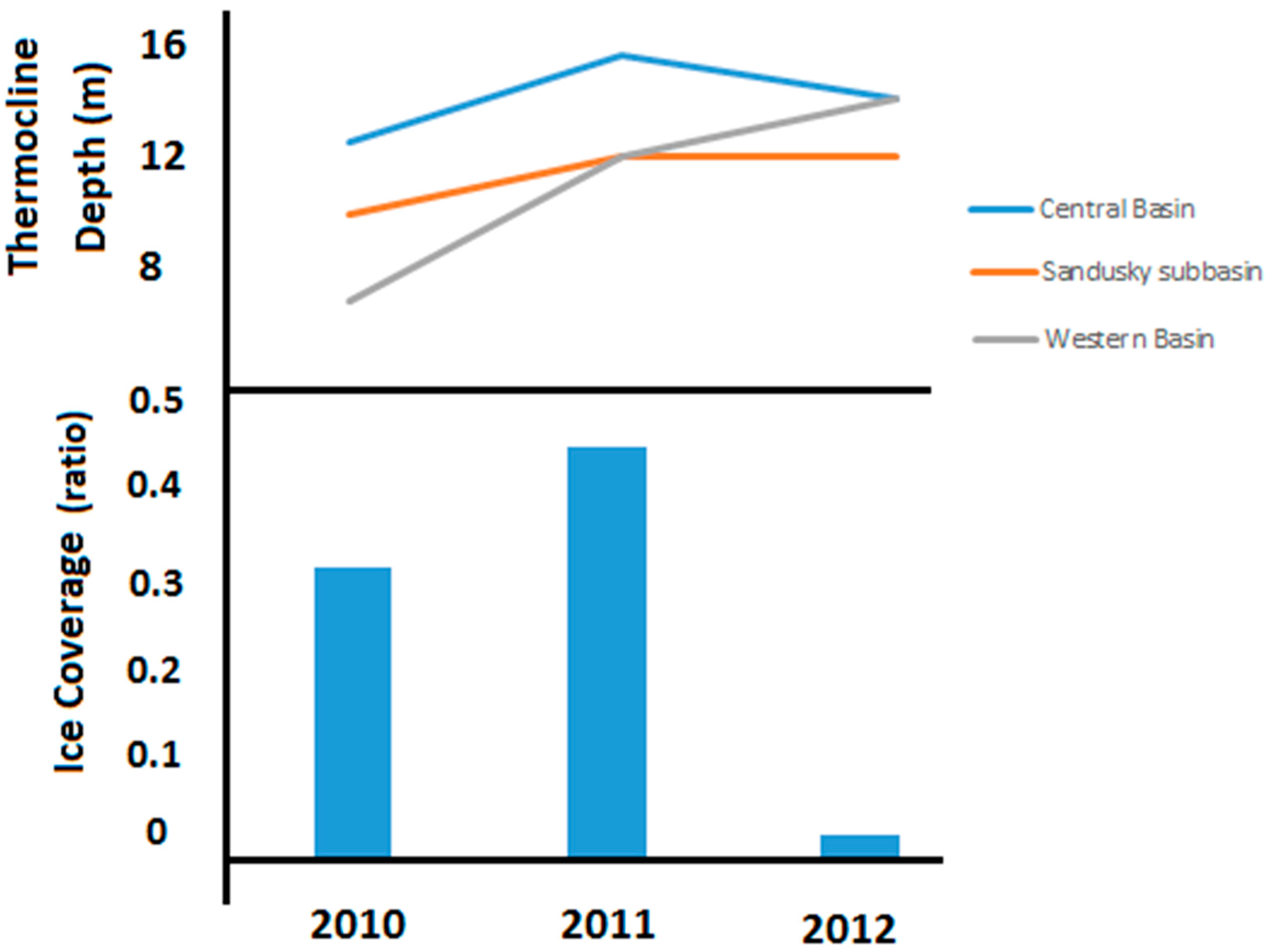

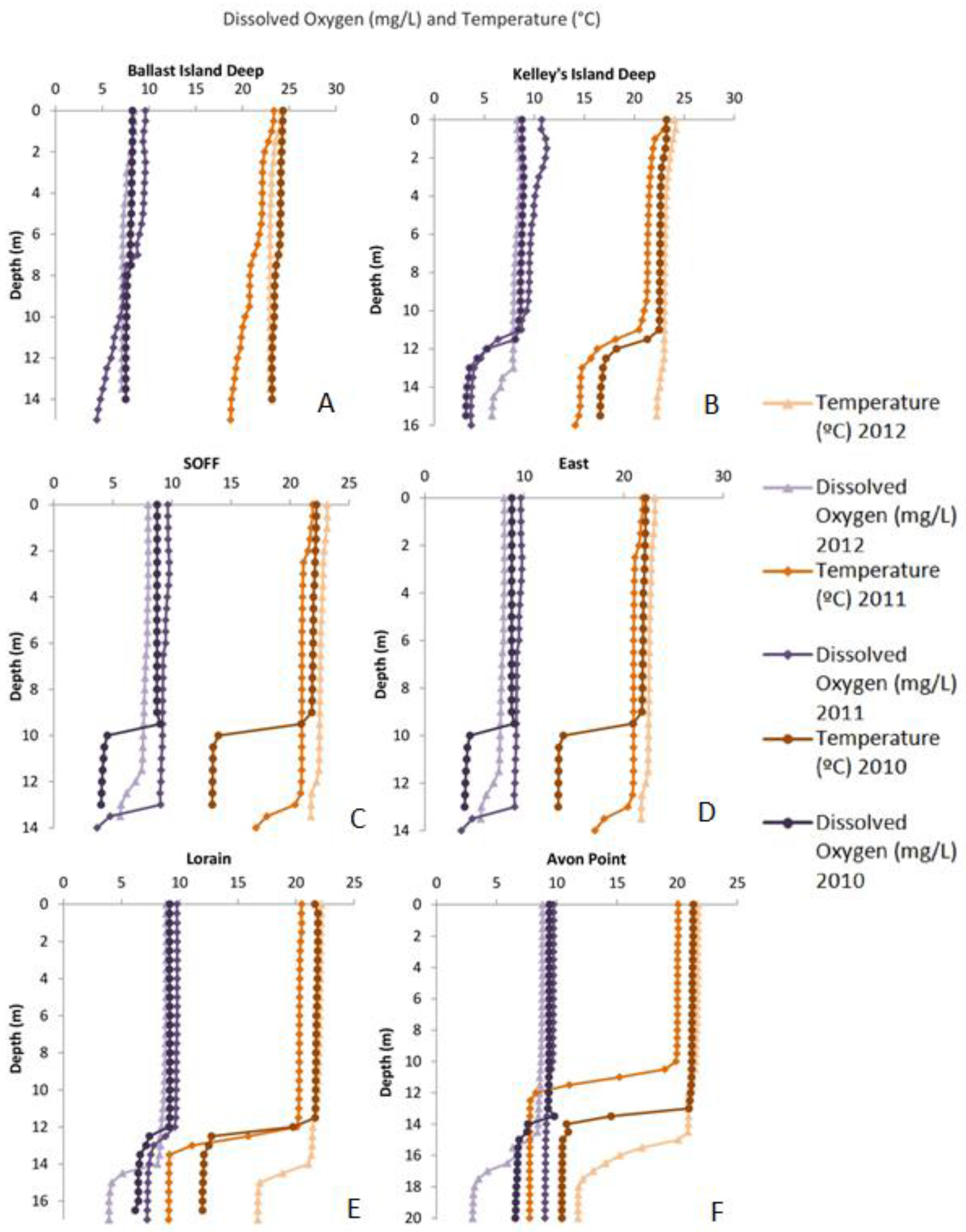
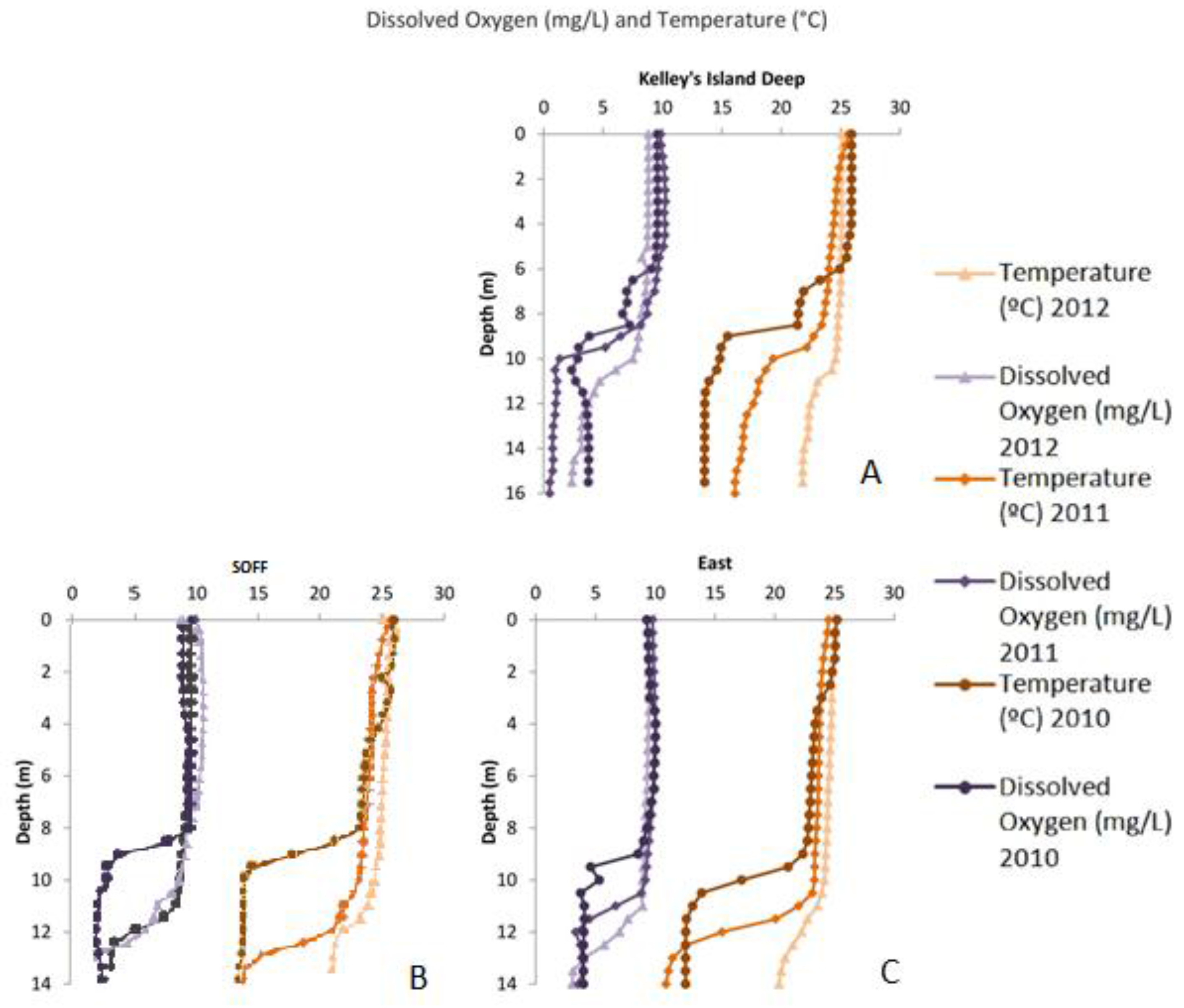
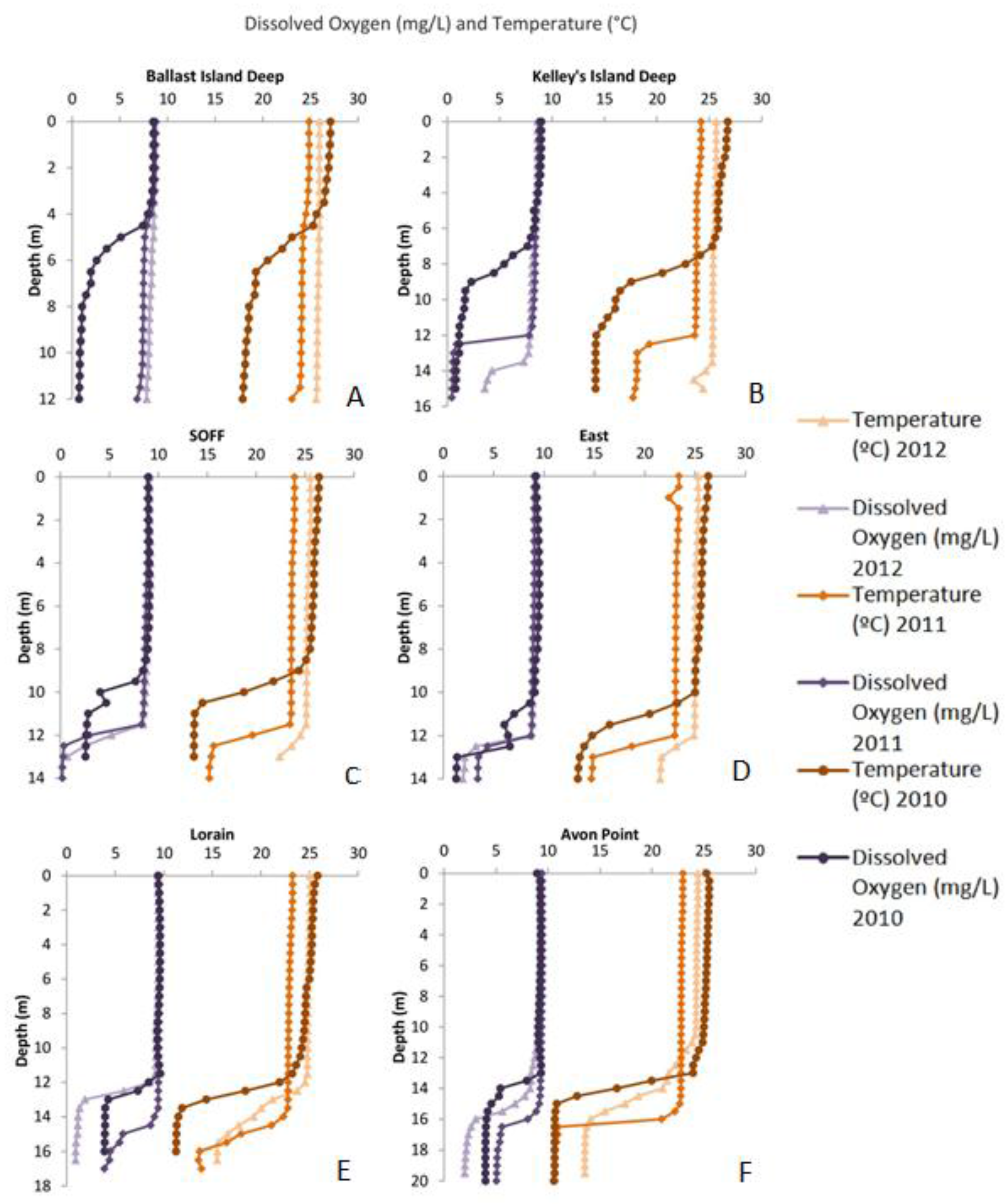
© 2017 by the authors. Licensee MDPI, Basel, Switzerland. This article is an open access article distributed under the terms and conditions of the Creative Commons Attribution (CC BY) license (http://creativecommons.org/licenses/by/4.0/).
Share and Cite
Perello, M.M.; Kane, D.D.; Golnick, P.; Hughes, M.C.; Thomas, M.A.; Conroy, J.D. Effects of Local Weather Variation on Water-Column Stratification and Hypoxia in the Western, Sandusky, and Central Basins of Lake Erie. Water 2017, 9, 279. https://doi.org/10.3390/w9040279
Perello MM, Kane DD, Golnick P, Hughes MC, Thomas MA, Conroy JD. Effects of Local Weather Variation on Water-Column Stratification and Hypoxia in the Western, Sandusky, and Central Basins of Lake Erie. Water. 2017; 9(4):279. https://doi.org/10.3390/w9040279
Chicago/Turabian StylePerello, Melanie M., Douglas D. Kane, Phoenix Golnick, Maya C. Hughes, Matt A. Thomas, and Joseph D. Conroy. 2017. "Effects of Local Weather Variation on Water-Column Stratification and Hypoxia in the Western, Sandusky, and Central Basins of Lake Erie" Water 9, no. 4: 279. https://doi.org/10.3390/w9040279





